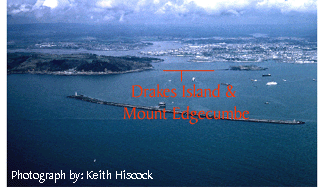
50 21.05N
04 09.90W
50 20.95N
04 09.83W
| Drakes Island and Mount Edgecumbe | ||
| Lat/long |  |
|
| 50 21.27N 50 21.05N |
04 09.34W 04 09.90W |
|
| 50 21.19N 50 20.95N |
04 09.29W 04 09.83W |
|
| Location description (1957) | |
| From their position off the mouth of the Hamoaze Estuary, the shores of Drake's Island and Mount Edgcumbe are affected by strong tidal currents, whilst at the same time they are sheltered from the south-west, and hence not exposed to the most violent wave-action. The shores of Drake's Island are rocky, the rocks, which are mainly composed of hard grit (volcanic tuffs), being generally steep and high. Between the rocks are small patches of stony ground, and of sand and gravels of various textures. The shores of Mount Edgcumbe resemble the stony patches on Drake's Island, and may be treated with them. They are connected by a shallow reef known as the Bridge of which the Mount Edgcumbe end is exposed at low water springs. The fauna on the rock faces resembles that at Rum Bay, and needs no further detailed description beyond the notice of the fact that (except at the Bridge at low water) the steeper character of the shore limits the area exposed at each tidal level. The overhanging ledges of rock are larger and more profusely covered than those at Rum Bay, but the same species are plentiful, Botryllus being dominant. The rocks, being on the whole either not laminated or less friable, do not possess such a varied crevice fauna, but Marphysa sanguinea and Polymnia nebulosa are plentiful in crevices at dead low water, the last also under stones. Stony ground between the rocks at Drake's Island and along the Mount Edgcumbe shore yields most of the species observed in similar conditions at Rum Bay; indeed at one time it was more favourable for some, such as Cucumaria saxicola and normani, and Myriothela cocksi. The amphipod Amphithoe rubricata which makes tubular nests, is common under stones. On the south side of Drake's Island a patch of clean shell gravel is exposed, hich is probably continuous with the shell gravel of Queen's Ground. Its fauna includes the crab Pirimela denticulata and the annelid Glycera gigantea. On the north-east side is a patch of sand, the most characteristic bit of clean even-grained sand in the district. Spisula solida, Natica alderi and Ammodytes spp. have been taken in it. A Zostera bed, sparser than formerly, occurs on the north side of the Island, but is now not exposed by the lowest tides. In this region Ensis spp. and a few Echinocardium cordatum can be obtained, whilst a patch of a few square yards of sand is crowded with Lutraria lutraria. |
| Updated information | No updated information |
| Species List | No information available. |